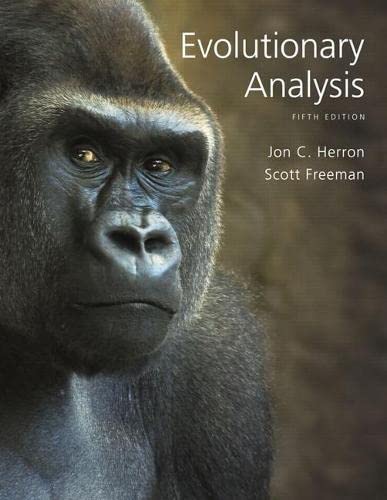Evolutionary Analysis 5th Edition Herron Freeman – Test Bank
Digital item No Waiting Time Instant DownloadISBN-10: 0321616677 ISBN-13: 978-0321616678Publisher : Pearson; 5th editionAuthors: Jon Herron, Scott Freeman
In Stock
Original price was: $55.00.$20.00Current price is: $20.00.
Evolutionary Analysis 5th Edition Herron Freeman – Test Bank
Test Bank for Evolutionary Analysis, 5th Edition by Scott Freeman and Jon C. Herron
The “Test Bank for Evolutionary Analysis, 5th Edition” by Scott Freeman and Jon C. Herron is an essential educational resource designed to support educators and students in mastering the principles and applications of evolutionary biology. This comprehensive test bank complements the textbook by offering a diverse array of questions that assess and reinforce understanding of key evolutionary concepts and practical skills, making it an invaluable tool for both teaching and learning. Below is a detailed overview of the components and benefits of this test bank:
Overview of Test Bank Content
- Chapter-by-Chapter Organization
- The test bank is meticulously organized to align with each chapter of the textbook, ensuring comprehensive coverage of all critical topics. This structure facilitates easy integration into the curriculum and enables targeted assessments.
- Types of Questions
- Multiple-Choice Questions (MCQs): These questions cover a broad spectrum of knowledge, from basic recall to complex application and critical thinking. Each question includes well-crafted distractors to challenge students’ understanding.
- True/False Questions: These questions evaluate students’ ability to distinguish between correct and incorrect statements, reinforcing factual knowledge and addressing common misconceptions.
- Fill-in-the-Blank Questions: These questions focus on recalling specific details such as key terms, evolutionary processes, and important concepts, testing students’ memory and understanding.
- Short Answer Questions: These questions require detailed yet concise responses, assessing students’ ability to explain evolutionary concepts clearly and accurately.
- Essay Questions: These questions evaluate students’ ability to synthesize and articulate complex ideas, demonstrating a deep understanding of evolutionary principles and their applications.
- Case Studies and Scenarios: Real-world scenarios and case studies help students apply theoretical knowledge to practical situations, enhancing their critical thinking and problem-solving skills.
- Difficulty Levels
- Questions are categorized by difficulty to provide a range of challenges and assess students’ proficiency at different levels, including:
- Basic: Testing foundational knowledge and comprehension.
- Intermediate: Requiring application of knowledge to practical evolutionary scenarios.
- Advanced: Involving critical thinking, analysis, and synthesis of complex evolutionary information.
- Questions are categorized by difficulty to provide a range of challenges and assess students’ proficiency at different levels, including:
- Core Focus Areas
- Introduction to Evolutionary Biology: Questions covering the basic principles and scope of evolutionary biology, including historical development and significance in science.
- Natural Selection: Detailed coverage of the mechanisms of natural selection, adaptation, and fitness.
- Genetic Drift and Gene Flow: Assessing knowledge of genetic drift, gene flow, and their effects on population genetics.
- Speciation: Focus on the processes of speciation, including allopatric, sympatric, and parapatric speciation.
- Phylogenetics: Examining the principles and methods of phylogenetic analysis, including tree construction and interpretation.
- Evolutionary Developmental Biology (Evo-Devo): Questions on the intersection of evolutionary and developmental biology, including the role of developmental genes in evolution.
- Molecular Evolution: Coverage of molecular evolution, including DNA sequence evolution, molecular clocks, and the neutral theory of molecular evolution.
- Evolution of Populations: Assessing understanding of population genetics, including Hardy-Weinberg equilibrium and factors affecting allele frequencies.
- Sexual Selection and Mating Systems: Questions on the principles of sexual selection, mating systems, and reproductive strategies.
- Co-evolution and Mutualism: Examining the interactions between species, including co-evolution, mutualism, and evolutionary arms races.
- Human Evolution: Focus on the evolution of Homo sapiens, including fossil evidence, genetic data, and the evolutionary significance of human traits.
- Evolutionary Ecology: Questions on the interactions between evolutionary processes and ecological factors, including life history strategies and ecological niches.
- Behavioral Evolution: Coverage of the evolution of behavior, including social behavior, cooperation, and communication.
- Macroevolutionary Patterns: Assessing knowledge of macroevolution, including mass extinctions, adaptive radiations, and long-term evolutionary trends.
- Alignment with Learning Objectives
- Each question in the test bank is aligned with the learning objectives outlined in the textbook, ensuring that assessments are relevant and targeted toward achieving the intended educational outcomes. This alignment helps in accurately measuring students’ progress and comprehension.
- Educational Support and Utility
- For educators, the test bank provides a comprehensive resource for creating quizzes, exams, and other assessments. It simplifies the process of test creation and ensures consistency and alignment with the curriculum.
- For students, the test bank serves as a valuable tool for self-assessment and study, helping them identify areas of strength and weakness and focus their efforts on areas needing improvement.
Benefits of Using the Test Bank
- Enhanced Learning and Retention
- The diverse range of question types and difficulty levels helps reinforce learning through varied and repeated exposure to key concepts, enhancing retention and understanding.
- Preparation for Real-World Applications
- By focusing on real-world scenarios and practical applications, the test bank prepares students for the practical aspects of evolutionary biology, ensuring they are ready to apply their knowledge in scientific and research settings.
- Comprehensive Assessment
- The test bank allows for thorough and multi-faceted evaluation of students’ knowledge and skills, from basic understanding to advanced application, ensuring a well-rounded educational experience.
- Efficient Teaching Resource
- For educators, the test bank simplifies the process of creating assessments, providing a consistent and reliable tool for evaluating students’ progress and readiness for advanced studies in evolutionary biology.
Conclusion
The “Test Bank for Evolutionary Analysis, 5th Edition” by Scott Freeman and Jon C. Herron is an essential resource for evolutionary biology education. It provides structured, comprehensive, and versatile tools for assessing and enhancing students’ knowledge and skills in evolutionary biology. By aligning closely with the textbook and emphasizing real-world application, the test bank supports the development of competent, confident professionals ready to excel in their understanding and application of evolutionary principles in various scientific, academic, and research settings.


Reviews
There are no reviews yet.